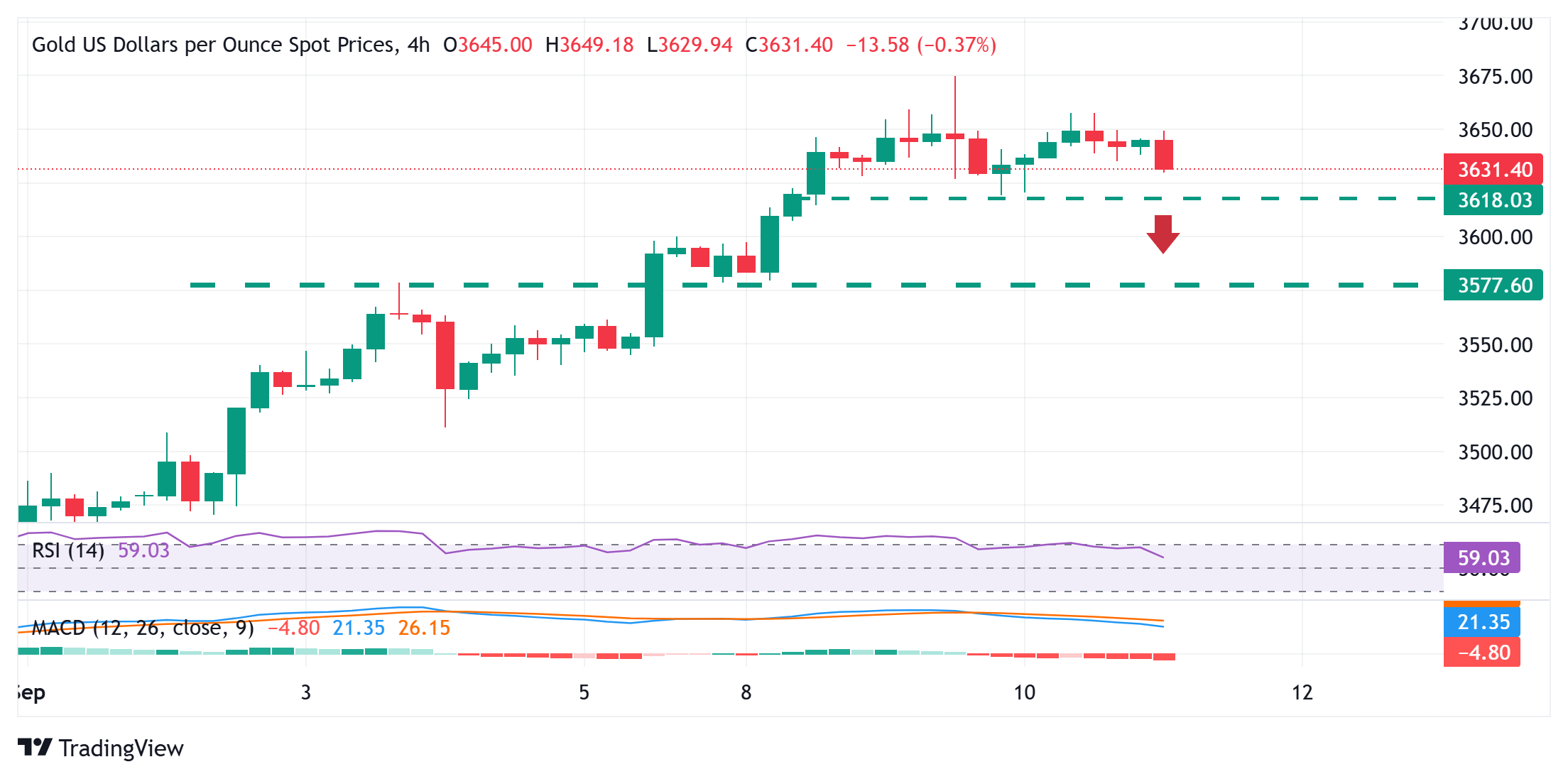Gold drifts lower amid risk-on mood and USD uptick, ahead of US CPI
- Gold struggles to capitalize on the previous day’s positive move and drifts lower on Thursday.
- A positive risk tone and a modest USD uptick prompt profit-taking around the precious metal.
- Fed rate cut bets could cap the USD and support the commodity ahead of the US CPI report.
Gold (XAU/USD) attracts some sellers during the Asian session on Thursday and reverses a part of the previous day's move up, though the downside potential seems limited. A generally positive tone around the equity markets is seen as a key factor acting as a headwind for the safe-haven precious metal. Apart from this, a modest US Dollar (USD) uptick undermines the commodity. Any meaningful USD appreciation, however, seems elusive amid firming expectations that the US Federal Reserve (Fed) will lower borrowing costs next week. This, in turn, might continue to lend some support to the non-yielding yellow metal.
Apart from this, persistent trade-related uncertainties, rising geopolitical tensions, and political uncertainty in France and Japan should contribute to limiting the downside for the Gold price. Traders might also opt to wait for the release of the US consumer inflation figures for cues about the possibility of a more aggressive policy easing by the Fed. The outlook, in turn, will play a key role in influencing the USD price dynamics and providing some meaningful impetus to the bullion. Hence, it will be prudent to wait for strong follow-through selling before positioning for an extension of this week's pullback from the all-time peak.
Daily Digest Market Movers: Gold bulls turn cautious ahead of US CPI report; Fed rate cut bets could limit losses
- The S&P 500 and Nasdaq posted record highs closely on Wednesday, while Japan’s Nikkei 225 index jumped over 1% to hit a fresh record high on Thursday. This, in turn, dents demand for traditional safe-haven assets and fails to assist the Gold to build on the previous day's positive move.
- The US Bureau of Labor Statistics (BLS) reported on Wednesday that the US Producer Price Index declined to 2.6% on a yearly basis in August from 3.3% in the previous month. Other details showed that the core PPI, which excludes food and energy prices, rose 2.8% YoY compared to 3.7% in July.
- The lack of producer price pressures, despite import tariffs, could be seen as sign of softening domestic demand against the backdrop of a struggling labor market. This, in turn, reaffirms market expectations that the US Federal Reserve will cut interest rates at its policy meeting next week.
- Furthermore, traders are pricing in a small possibility of a jumbo rate cut on September 17 and expect the Fed to deliver three 25-basis-point rate cuts by the end of this year. This should cap the US Dollar recovery from its lowest level since July 28 and support the non-yielding yellow metal.
- On the trade-related front, US President Donald Trump has urged the European Union to slap 100% tariffs on China and India as part of his efforts to pressure Russia to end its war in Ukraine. Trump last month raised tariffs on Indian imports to 50%, citing continuing purchases of Russian oil.
- Meanwhile, Poland shot down Russian drones on Wednesday that were flying over its airspace after completing a mission in western Ukraine. This is the first time a NATO member nation has fired shots in Russia’s war on Ukraine, raising the risk of a further escalation of geopolitical tensions.
- Furthermore, Trump has threatened tougher sanctions against Russia after its heaviest aerial bombardment on Ukraine, which involved at least 810 drones and 13 missiles. This could further benefit the precious metal's safe-haven status and contribute to limiting any meaningful corrective slide.
Gold could accelerate the corrective pullback below $3,600 amid still overbought daily RSI

The daily Relative Strength Index (RSI) remains in overbought territory and backs the case for some near-term consolidation or a further pullback. However, any further slide below the overnight swing low, around the $3,620 area, could find some support near the $3,600 round-figure mark ahead of the weekly trough , around the $3,580 region. A convincing break below the latter could pave the way for deeper losses and drag the Gold towards the $3,565-3,560 intermediate support en route to last Thursday's swing low, around the $3,510 region.
On the flip side, the Asian session top, around the $3,649 area, followed by the overnight swing high, around the $3,657-3,658 region, might now act as immediate hurdles, above which the Gold could retest the all-time peak, around the $3,675 zone. Some follow-through buying could allow the XAU/USD pair to build on the recent breakout momentum and aim towards conquering the $3,700 mark. Bulls, however, might refrain from placing aggressive bets and pause near the said handle, which could act as a strong near-term barrier for the commodity.
Gold FAQs
Gold has played a key role in human’s history as it has been widely used as a store of value and medium of exchange. Currently, apart from its shine and usage for jewelry, the precious metal is widely seen as a safe-haven asset, meaning that it is considered a good investment during turbulent times. Gold is also widely seen as a hedge against inflation and against depreciating currencies as it doesn’t rely on any specific issuer or government.
Central banks are the biggest Gold holders. In their aim to support their currencies in turbulent times, central banks tend to diversify their reserves and buy Gold to improve the perceived strength of the economy and the currency. High Gold reserves can be a source of trust for a country’s solvency. Central banks added 1,136 tonnes of Gold worth around $70 billion to their reserves in 2022, according to data from the World Gold Council. This is the highest yearly purchase since records began. Central banks from emerging economies such as China, India and Turkey are quickly increasing their Gold reserves.
Gold has an inverse correlation with the US Dollar and US Treasuries, which are both major reserve and safe-haven assets. When the Dollar depreciates, Gold tends to rise, enabling investors and central banks to diversify their assets in turbulent times. Gold is also inversely correlated with risk assets. A rally in the stock market tends to weaken Gold price, while sell-offs in riskier markets tend to favor the precious metal.
The price can move due to a wide range of factors. Geopolitical instability or fears of a deep recession can quickly make Gold price escalate due to its safe-haven status. As a yield-less asset, Gold tends to rise with lower interest rates, while higher cost of money usually weighs down on the yellow metal. Still, most moves depend on how the US Dollar (USD) behaves as the asset is priced in dollars (XAU/USD). A strong Dollar tends to keep the price of Gold controlled, whereas a weaker Dollar is likely to push Gold prices up.

